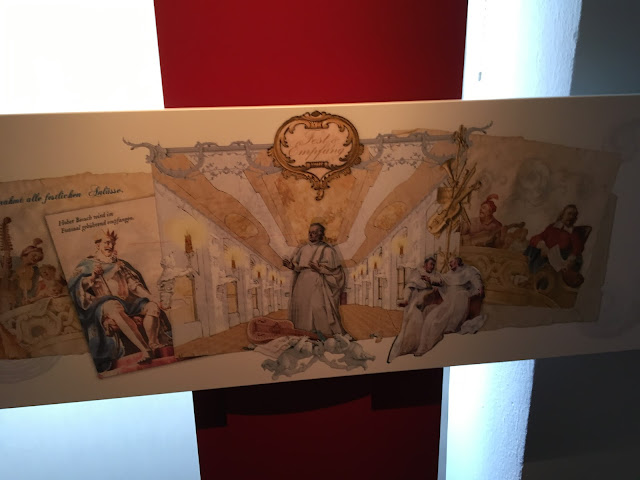I had heard of this place and was looking forward to a visit. The pictures had showed a huge complex. We were not disappointed.The fantastic Baroque pews in the church, the wonderful library, and the fascinating museum are uppermost in my memory. I am so pleased to be able to share our photos.
The abbey was founded from Rot an der Rot in 1183 by the local landowners Berengar and Konrad of Schussenried. Pope Innocent III granted it protection and immunity in 1211. From there it received substantial endowments thereby building up territory and it was declared an Imperial Abbey in 1440. There was great fire damage in the Thirty Years War and the lands were laid waste by the marauding Swedes.
Recovery followed and by the 18th century a rebuild was in progress. Dominikus Zimmermann produced a plan for four wings with an integrated church. This was never completed because of lack of funds. The present three winged abbey has a north wing plus stumps of the intended east and west wings - about a third of the planned complex!
After 1803 the abbey and its lands passed to the Counts of Sternberg-Manderscheid to compensate them for their lossed west of the Rhine.They used it as their castle. Then the territory passed to the King of Wurttemberg and the Counts sold them the buildings in 1835. In 1875 a nursing home was establised and until 1997 this was the State Psychiatric Hospital of Bad Schussenried. Since 1998 an exhibition and event centre has been set up.
The magnificent library features lockable bookcases in two storeys. The ornamentation is outstanding. The fantastic ceiling fresco is by Franz Georg Hermann (1757) of the Divine Wisdom with apocalypse, scholarship, education and craft. Included in the fresco is the famous Canon Caspar Mohr (1575-1625)with his feathered flying machine. Caspar was something of a genius. Apparently he was painter, carpenter, gardener, locksmith, blacksmith, musician, organ builder and watchmaker. He went away to study theology in Rome, and also acted as prior at Schussenried. His main claim to fame however was the flying machine. His foot-operated flying machine was to work by body movement.For this purpose he strapped wings of goose feathers on his back, which were connected by strings with his feet. With loops, he held the wings to his hands so he could swing like a bird. The abbot begged him not to jump from his third floor of the monastery. Anyway whatever spectacular aviatic activities he undertook he die on a spa stay in Jebenhausen in 1625!
The Abbey church is now the parish church of St Magnus. Part Romanesque and part Baroque it features magnificent walnut stalls by Georg Anton Macheln (1685-1739) which he undertook in 1715-1717. The ceiling frescos of the life of St Norbert of Xanten are by Johannes Zick. St Norbert was the founder of the Premonstatensian order, which occupied the Abbey 1512-1803.
 |
| The Library set out for a concert. Note organ in the gallery. |
 |
| Another shot of the Library |
 |
| Love that organ |
 |
| Throne of King Solomon Theology |
 |
| Rhetoric Caspar Mohr hovers above blue figures |
 |
| Apocalyse in centre |
 |
| Imagine you were performing! |
 |
| The exquisite lockable two storey bookcases.... |
 |
| 18th century Choir monks in full regalia |
The Museum was very spectacular and featured a display about how the 18th century monk lived.
 |
| Refreshment and reading.... |
 |
| Can't make this out but I like the image |
 |
| Abbot's dwelling and guest room |
 |
| Worship |
 |
| 18th century Choir stalls in Church of St Magnus |
 |
| Detail of choir stall |
 |
| Scenes from life of St Norbert by Johannes Zick |
 |
| Nave of St Magnus |
 |
| Choir with the famous stalls |



















No comments:
Post a Comment